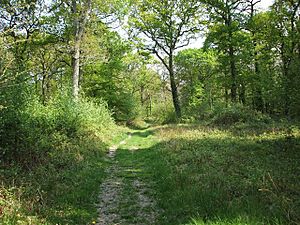Mottisfont Bats facts for kids
| Site of Special Scientific Interest | |
 |
|
| Area of Search | Hampshire |
|---|---|
| Interest | Biological |
| Area | 196.7 hectares (486 acres) |
| Notification | 2003 |
| Location map | Magic Map |
Mottisfont Bats is a very special place in Hampshire, England. It's a large area of woods, about 196.7-hectare (486-acre) (that's like 486 football fields!). This site is important because it's a home for many different kinds of bats. It's officially called a "Site of Special Scientific Interest" (SSSI) and a "Special Area of Conservation" (SAC). This means it's protected to help nature thrive.
Contents
Mottisfont Bats: A Special Home for These Flying Mammals
Mottisfont Bats is located west of Winchester in Hampshire. It was officially recognized as a special place in 2003. The main reason it's so important is because of the bats that live there.
Why Mottisfont is Super Important for Bats
This area is especially important for a rare bat called the barbastelle bat. Natural England, a group that protects nature, says these bats are nationally important. Mottisfont is where barbastelles come to have their babies, rest, travel, and find food.
It's the only place in Hampshire where barbastelle bats are known to have their maternity roosts. A maternity roost is a safe place where female bats gather to give birth and raise their young. As of 2002, Mottisfont was one of only six such known sites in the entire United Kingdom!
Other Bat Species You Might Find
Besides the special barbastelle bat, eight other types of bats have been seen at Mottisfont. These include:
- Whiskered bats
- Brown long-eared bats
- Common pipistrelles
- Soprano pipistrelles
- Serotine bats
- Noctule bats
- Daubenton's bats
- Natterer's bats
Each of these bats has its own unique way of living and finding food, making the woods a busy place at night!
The Woods of Mottisfont
The Mottisfont site has a mix of different types of woodlands. This variety helps support all the different bat species and other wildlife. Some of the woodland types include:
- Hazel coppice with standards: This is where hazel trees are cut back regularly to encourage new growth, with some taller trees (standards) left to grow.
- Broadleaved plantation: These are areas where trees with wide, flat leaves (like oak or beech) have been planted.
- Coniferous plantation: These areas have trees that produce cones and have needles (like pine or fir).
This mix of trees provides different places for bats to roost, hunt for insects, and travel safely through the landscape.

